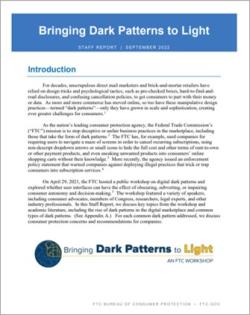It’s ironic that the only thing clear about digital dark patterns is the FTC’s commitment to protect consumers from the injury they inflict. A new FTC Staff Report sheds light on the ways that marketers can manipulate people into buying merchandise or giving up personal information through the use of dark patterns – a phrase that describes a broad range of deceptive design elements. If your business is involved in web-based commerce, the Report discusses in detail a number of the practices that raise consumer protection concerns.

As the FTC’s 2021 workshop, Bringing Dark Patterns to Light, and recent academic literature establish, dark patterns take on a variety of nefarious guises – for example, hiding the full cost of a transaction behind nondescript dropdown arrows or small icons, sending people on a digital scavenger hunt just to cancel a subscription, using default settings to subvert their privacy choices, or even sneaking stuff into customers’ shopping carts without their knowledge. Dark patterns also may lurk in different locations – behind cookie consent banners, inside kids’ apps, and within “free” offers, to name just a few.
You’ll want to read the Report to take a deeper dive into dark patterns, but here are four examples the Report cites:
- Design elements that cause false beliefs. An example of this tactic is when marketers use deceptive “masquer-ads” that look like independent editorial content, but really are advertising.
- Design elements that hide key information. This category includes the practice of burying additional fees, mandatory charges, or “drip pricing” in hard-to-find or even harder-to-understand blocks of text, often late in the transaction.
- Design elements that lead to unauthorized charges. Marketers that take advantage of these dark patterns typically trick people into paying for goods or services they didn’t want and then bill them – often on a recurring basis – without their consent.
- Design elements that trick customers into sharing personal data. These dark patterns often appear to give consumers a choice about sharing data, but then intentionally steer them to the option that gives away the most personal information.
Another instructive resource in the Report is an analysis of recent FTC cases that have challenged allegedly illegal dark patterns. But the Report doesn’t just discuss the contours of the problem. It also makes practical recommendations for companies as they develop, design, and improve their online interfaces.
The Report sends two strong signals. Consumers, the FTC is on your side in the fight against digital booby traps designed to take your money and your data. Businesses that use dark patterns, consider this Report the written equivalent of that point-to-our-eyes-and-then-point-you gesture. We’re on to what you’re up to and will take action to protect people from deceptive or unfair schemes and subterfuges.

It is your choice whether to submit a comment. If you do, you must create a user name, or we will not post your comment. The Federal Trade Commission Act authorizes this information collection for purposes of managing online comments. Comments and user names are part of the Federal Trade Commission’s (FTC) public records system, and user names also are part of the FTC’s computer user records system. We may routinely use these records as described in the FTC’s Privacy Act system notices. For more information on how the FTC handles information that we collect, please read our privacy policy.
The purpose of this blog and its comments section is to inform readers about Federal Trade Commission activity, and share information to help them avoid, report, and recover from fraud, scams, and bad business practices. Your thoughts, ideas, and concerns are welcome, and we encourage comments. But keep in mind, this is a moderated blog. We review all comments before they are posted, and we won’t post comments that don’t comply with our commenting policy. We expect commenters to treat each other and the blog writers with respect.
We don't edit comments to remove objectionable content, so please ensure that your comment contains none of the above. The comments posted on this blog become part of the public domain. To protect your privacy and the privacy of other people, please do not include personal information. Opinions in comments that appear in this blog belong to the individuals who expressed them. They do not belong to or represent views of the Federal Trade Commission.
I'm so happy someone is taking a stand against the sites that are doing exactly what you have described, I've been a victim of this practice on several occasions and had to put in a lot of time and money to correct it, the largest companies that do this is the one's that offer you information for a one time fee, so I thank you gratefully Linda